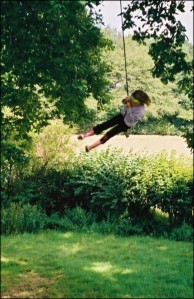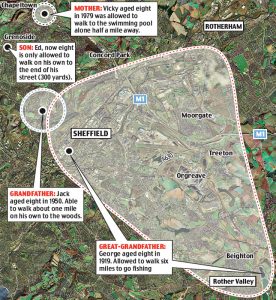 Where was your favourite place to play as a child? The chances are, it was out of doors, and out of sight of adults. A place where you felt a sense of freedom and possibility. Where you could follow your impulses and your imagination, even if that led you into situations that were scary, challenging, perhaps even downright dangerous.
Where was your favourite place to play as a child? The chances are, it was out of doors, and out of sight of adults. A place where you felt a sense of freedom and possibility. Where you could follow your impulses and your imagination, even if that led you into situations that were scary, challenging, perhaps even downright dangerous.
It is not mere nostalgia to revive these memories. Of course, we should not fall for the myth that there was a ‘golden age’ for growing up. But if we all agree that a taste of freedom and adventure are vital ingredients of a good childhood, then surely we should see to it that children today are able to enjoy similar experiences.
Sadly, these experiences are under threat. When people say that children grow up faster today, they are confusing appearance with reality. Children may be avid consumers of adult culture. They may adopt adult mannerisms and styles. They certainly get to grips with new technology far more easily than we grown-ups. But when it comes to everyday freedoms – like walking to school alone, or meeting friends in the park – a very different picture emerges.
The fact is that for the last thirty or forty years or longer, across the developed world, the horizons of childhood have been shrinking, and adult control and oversight is becoming the norm. For instance, here in the UK, in 1971 almost 90 per cent of eight-year-olds went to school without their parents. By 1990 it was just 11 per cent.
Why has this happened? As I argue in my book No Fear, the causes are many and varied, and cannot simply be blamed on parents. Neighbourhoods are more dominated by cars, and families more dependent on them. Changing family working patterns mean fewer parents are around to watch over children, and more children are in formal childcare. In many areas, people don’t know their neighbours, and there is greater fear of crime. All these factors, and others, reinforce the logic of containment.
However, some parents are actively resisting the pressures to overprotect. In the USA, journalist and mum Lenore Skenazy was inspired to write her book and blog Free Range Kids after finding herself at the centre of a media storm for letting her nine-year-old son travel alone on the New York subway.
What motivates Skenazy, and me in my own work, is the conviction that ‘battery-rearing’ children does not help to prepare them for the ups and downs of everyday life. Childhood is a journey from dependence to autonomy. At the heart of this journey is a transfer of responsibility from adult to child. So we have to give children some opportunity for freedom and exploration. Not least because children themselves want to get to grips with the world on their own terms.
One of ways we do this is by creating environments for outdoor play. Play spaces are a fascinating arena for exploring ideas about risk and responsibility. On the one hand, they need to engage and stimulate children: to give them challenges, and the chance to test themselves through their play. On the other, they should not be places where children are regularly coming to serious harm. What is needed is a balanced approach.
The idea of balance has come to the fore here in the UK. But it was not always so. Ten years ago, schools and municipalities were becoming preoccupied with safety. Many believed they had to eliminate risk. Some of the resulting playgrounds were very dull indeed.
Those of us involved in play safety at the national level felt we had to take action. We went back to first principles, and had a long hard look at what playgrounds were for in the first place. We argued for a more balanced approach to risk. What is more, we got support from the UK Government’s own Health and Safety Executive (HSE). This work has been the catalyst for a sea change in professional attitudes about play safety.
The climate around play safety is continuing to improve. In 2008 the UK Government published Managing Risk in Play Provision: Implementation Guide. And it is ripping up all the old rules. Instead of conducting risk assessments, providers are encouraged to carry out risk-benefit assessments. This simple yet far-reaching shift means that for the first time, providers will be able to take into account the benefits of giving children challenging, risky experiences.
[Update 13 Sep 2012: the HSE has issued an important statement supporting the risk-benefit approach. Read more here.]
In the wake of this work, some of the latest playgrounds are genuinely exciting, engaging places to play. For instance, sand pits have been included in several new play areas in the London Borough of Islington, even though the municipality was initially worried about the risk of contamination from broken glass or animal faeces. Using risk-benefit assessment helped to think through the pros and cons [pdf link – from PLAYLINK] leading to revised maintenance regimes and reduced costs.
The idea of balancing risks and benefits is spreading beyond the public playground into educational settings, and has reached the highest echelons of power. The Government-sponsored Young Review into health and safety gave risk-benefit assessment a ringing endorsement, and called for the approach to be developed more widely. The report’s recommendations were supported in full by the Prime Minister.
None of this means that we simply abandon children to their fate, or complacently shrug our shoulders when they come to harm. History teaches us that children have suffered all too often because of the failings of adults. But history – in the form of our recollections of our own childhood memories – also teaches us an invaluable lesson: that giving children the chance to learn from their experiences, and learn from their mistakes, is part and parcel of a good childhood.
- Acknowledgement: This article is an edited, updated version of one published by Children in Europe magazine in 2010.



Great article-Wholeheartedly agree with the concept that our own experience as children should serve as a guide to how and where our children play.
Brilliant, ans brilliantly useful given that I’m doing a play inquiry on risk right now! Thanks for all the links!
More good stuff Tim.
On this theme – I’ve been asked to help some local authority play people by supporting them to understand the RBA process in a practical hands-on way, so that they can carry out their own assessments with confidence. I think it’s encouraging that some LAs are embracing RBA after all the years of campaigning by you and the others, many of who are PSF members. We just have to keep plugging away until it becomes standard practice everywhere.
kidsplayunplugged, Aunt Annie’s Childcare, Neil – thanks for the positive feedback. Neil – you’re right to highlight that winning over LAs and others is a gradual process. And I agree are making real progress – not just through the efforts of the Play Safety Forum, but also thanks to LA officers and others like you working face to face with providers. Keep up the good work!
Brilliant indeed. Kind of confirms a lot of what many of us have long suspected. Avoiding play and life is a pretty big risk, to me.
There needs to be a learning experience that enables our children to assess and deal with risk. I’d rather not wait for my child to grow up and be behind the wheel of a car before having an opportunity to hone these skills. This does not mean being reckless, rather being responsible and allowing some freedoms and accepting that some accidents are just that, not potential litigation events.
Kimberley, Helen – thanks for these comments. Helen – as the father of a 13-year-old I find your comment very apposite!
Pingback: Childhood and risk: what messages would you give to the Palace? | Rethinking Childhood
Hi Tim I am finding your website very valuable and keep checking my twitter feed. I run a scrapstore in Leeds and we are filling containers with loose parts play and placing them within school playgrounds and pop up shops. Our main stumbling block is risky play but we are seeing a definate change in attitude within schools by educators. Its great to see this change and it is a relief to see that people are opening up to this change.I do believe the majority of parents are willing to let their children take measured risks, I know I do with my 7 year old and she is very confident and although does have minor accidents she learns pretty quickly how things work.
Pingback: Out of sight, out of mind? | Rethinking Childhood
Pingback: It’s health and safety gone sane! | Rethinking Childhood
Pingback: A century of rethinking childhood | Rethinking Childhood
Pingback: The wobbly bridge, or why it is harder to manage risk in playgrounds than factories | Rethinking Childhood
Excellent analysis ! I Appreciate the information ! Does anyone know if my business would be able to access a blank WKBKY Form 01.086 Letter of Intent example to fill out ?
i so agree –